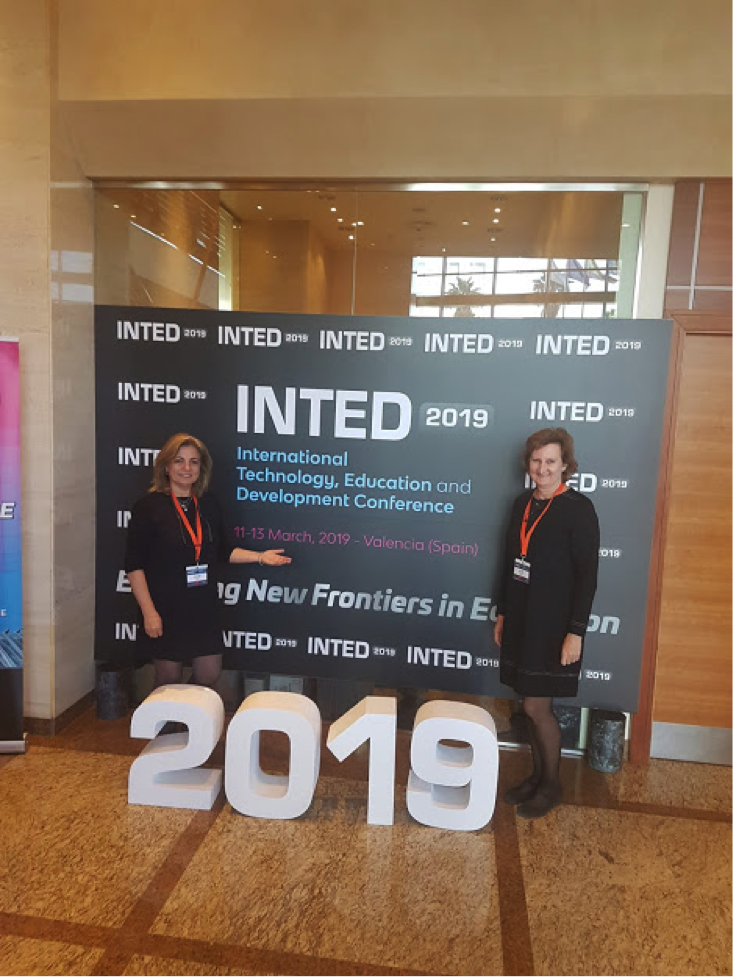
Reflections and Highlights: INTED 2019 in Valencia
Our Session: (please see the presentation here)
To go online or not? The journey to a specific, online ELT teacher training course in Turkey
N. Ozgirin, S. Celtek
Sabanci University (TURKEY)
School of Languages Teaching and Developing Through Online Learning: Vocabulary Teaching and Learning (SL-TeDOL, VTL) is a free online teacher training course, designed by a couple of voluntary instructors at Sabancı University, Istanbul, to help ELT teachers in Turkey or abroad revise or improve their vocabulary teaching and learning skills.
One of the missions of Sabancı University is to share the knowledge and skills gained through institutional studies with the environment for the benefit of the society. Education is indispensable in that it helps improve the knowledge and skills of a society. However, due to the uneven distribution of resources, some members of a society may be educationally disadvantaged. Unfortunately, in this fast-changing global world, the state education systems cannot always catch up with the technological benefits.
As a university, in the past, we provided a lot of support to different groups of ELT teachers working at state schools by visiting different cities and giving weekly educational seminars. However, this kind of training is neither sustainable nor satisfactory for all kinds of teachers with different needs and backgrounds. Providing free education through online systems has become more important in this respect. The SL-TeDOL, VTL course has been supported by our university in terms of time and resources. We, as the designers of the course, would like to share our experience of the preparation, design and administration process. We will also share some key points and lessons learnt based on the process and feedback from the pilot course participants.
Interactive session 1: Learning Transformed: 8 Keys to designing Tomorrow’s School
by Eric Sheninger
Key note speaker at INTED 2019
Never in human history have we seen so many technologies moving at such a pace…. And everything is being disrupted in the process.” Selim İsmail, Exponential organizations: Why New Organizations Are Ten Times Better, Faster, and Cheaper Than Yours
In this interactive session Sheninger started with a mentimeter poll that collected the participants understanding of ‘innovation’. Later, he focused on the change in the ‘Top 10 skills important in the workforce’ in 2015 and 2020. He claimed that with all that is known about how students learn and the predictions regarding the world that our students will face tomorrow, a one‑size‑fits‑all approach to teaching and learning is educational malpractice (2019). Some examples he gave to demonstrate the change were ‘Uber’, ‘Airbnb’, and Netflix. He stated that the learning experience should be redesigned to shift the teaching and learning paradigm to one that is personal to build the foundation of leadership and school culture. He referred to the skills of 21st Century critical thinkers as rigor: thoughtful work, high-level questioning, academic discussion, relevance: meaningful work, authentic resources, learning connections, and engagement: active participation, learning environment and formative processes and tools.
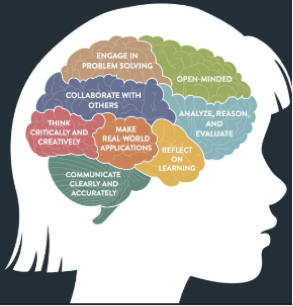 He also referred to a study done by Stanford University, SCOPE, to give 3 key findings for what works with EdTech: 1. Interactive learning; 2. Use of technology to explore and create rather than to “drill and kill”; and 3. The right blend of teachers and technology.
He also referred to a study done by Stanford University, SCOPE, to give 3 key findings for what works with EdTech: 1. Interactive learning; 2. Use of technology to explore and create rather than to “drill and kill”; and 3. The right blend of teachers and technology.
He shared some evaluative questions institutions can answer to evaluate their systems.
●What evidence do we have to demonstrate the impact of technology and innovation on school culture?
●How are we making learning relevant for our students?
●How do we implement and support rigorous and relevant learning tasks that help students become future ready?
●How are we using data to close achievement gaps, make informed decisions, and personalized learning?
●What observable evidence can be used to measure the effect of technology and innovative ideas are having on student learning and achievement?
●How can targeted feedback be provided to our teachers and students, so that technology can enhance learning?
Sheninger asked the question “In the past 100 years, how much has the classroom setting really changed?” and used the simile ‘The cemetery effect’ to describe the effect of this kind of classroom setting. To prepare students for the world of work tomorrow, he recommended to focus on the ‘what ifs’ instead of ‘yeah buts’. For him the magic begins when people get out of their comfort zones. Everybody says they want change, but who wants to lead the change? He claimed that “You can’t just want change. You need to lead and be the change”. He also claimed people do not learn from experience, they learn from reflection on experience. He gave the following characteristics for leaders in school culture.
Learn
Empower
Adapt
Delegate
Engage
Reflect
Serve
Sheninger suggests the use of ‘The Rigor /Relevance Framework’ as an instructional tool. If a lesson or task is relevant, the students will be able to see the relevance/purpose: why they learnt it, how they will use it outside and what they learnt. In brief, rigor makes the future possible, The question is ‘Who is doing the task?’. In teaching, quadrant D, where ‘Student works and thinks’ is the challenge. Rather than focusing on where the information is, look for ways of using it. Possible verbs to adopt for this are ‘argue, create, explore, invent, modify, plan and predict. Finally, he said that evidence matters. Decisions must be grounded in evidence and driven by a return on instruction that results in evidence of improved learning outcomes. These artifacts can consist of writing samples, presentations, projects, photos, audio or video files.
Finally he focused on what learning spaces should include:
1. Naturalness (light, air and safety)
2. Individualization (having choice)
3. Appropriate level of stimulation (too many posters or colors may be disruptive)
4. Shifting spaces requires changing pedagogy (Do the spaces in your school or district match your desired pedagogy?)
5. Blended instruction is what the teacher does with technology, whereas blended learning is where students use technology to have control over their learning path, place and pace.
6. How does digital support sound pedagogy? A natural pedagogical fit would be: anticipatory (set/do now), review prior learning, checking for understanding, application of learning, guided/independent practice, assessment, feedback and closure.
Seninger finished his session asking the questions “Everyday, in every area of your schools, great things happen. How does your community know? What are you doing to tell the story of the great things?
Interactive session 2: Diving Deeper in how neuroscience is changing what we know about learning: Practical insights for instructors.
by Barbara Oakley, the keynote speaker, INTED 2019
Barbara Oakley, who is an instructor on some of the most famous massive open online courses (MOOCs) on Coursera, (Learning How to Learn, , Mindshift...etc.), said that instructors often have a feel for what they’re supposed to be teaching in the classroom even though they may not know why. In her talk she shared her belief that learning how the brain learns will help see the restrictions of working memory. This will give a better idea of structuring teaching so that student cognitive overload can be avoided. She also aimed to demonstrate how to help students neurally encode information, concepts and techniques into long term memory. She covered the following key points for learning.
Firstly she talked about two important modes: focused and diffuse modes. While focus mode is needed when paying attention to something or learning, diffuse mode is essential to consolidate what is learnt, to organize information and to create connections and deeper understanding. She says it is helpful to have some inactive breaks, therefore, giving little mental breaks is useful for the brain.
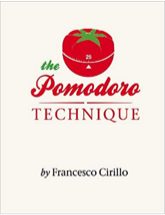
Procrastination was mentioned as the biggest challenge for students. She strongly suggested the use of the Pomodoro technique, a time management method, developed by Francesco Cirillo in the late 1980s. It suggests the use of a timer to break down work into short intervals (25 minutes in length-separated by short breaks).
Although procrastination provides a temporary feeling of happiness as the person pays attention to a more pleasant task at the moment, it ends up with an unhappy feeling. She says when students use the method, the pain will go away after 20 minutes. She also suggests rewarding yourself. You can find more information about the technique in the link Pomodoro technique.
She gave more information about the effect size of studying with music or without music or different types of knowledge. First, biologically primary knowledge, such as recognizing faces, listening to and speaking a first language is acquired easily. Second, biologically secondary type of knowledge is related to reading and writing. As these do not evolve through acquisition, new neutral circuits need to be created and so it is harder for the students to improve this kind of knowledge.

Basically, based on Geary and Berch studies, she says learning gets easier if it is guided or directed by the teacher if it is biologically secondary.
She also emphasized the role of metaphors in learning and suggested some methods like taking them from others, asking yourself what a concept is like and asking students to develop them.
Interactive session: Design Thinking Lab
By Wendy Gorton
USA
This interactive Google design thinking session, which was given by Wendy Gorton, who is from the EdTechTeam-US was one of the most useful sessions of the event in terms of sharing a good model that incorporates an effective process that leads to innovative outcome design with a group of participants. This action-packed model demonstrated how Google uses design thinking as a model to tackle the challenge of design and innovative thinking in education. In the session we ran through an entire design sprint and shared resources for running our own sprint with our school and team and designed a product together using the stages of Understand, Define, Sketch, Decide, Prototype, and Validate. The session provided many tips and useful language and questions to be used during the process. For example, the participants were encouraged to uncover the needs of their users through stories, emotions, and insights with a goal that is not to think up new ideas or find solutions as this prevents them from seeing their reality, but to listen and ask for feedback rather than jumping to conclusions. The chart below shows the stages of the model.
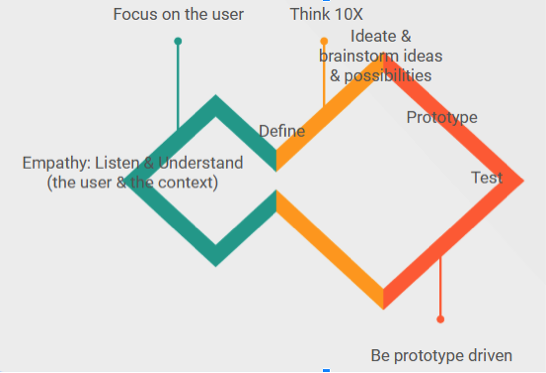
See below for more google programs and support
Dynamic learning Project and its presentation .
Session: How I gamified my college classroom: what worked, what didn’t and why I can’t wait to do it again
By J. Smith (US)
Smith talked about how she changed her PBL based media literacy class into a more engaging learning environment by changing the names of the course components rather than making big alterations. She overviewed what research has failed to incorporate in ways of classroom gamification by referring to the following points:
●much of the research focuses on how rewarding badges isn't enough (Hamari, 2017) or
●how adding game elements to online learning environments can slightly increase engagement (Jang, Park, Yi 2015).
However, she claimed that there was not much research on the impacts of gamifying an actual university course. She presented how she added gaming elements to her ‘Introduction to Mass Media’ survey course without changing the content of the course and their effect on increased engagement, attendance and student outcomes.
Gamification requires specific goals before implementation (Kim, 2015). She shared the aim of her course as turning the large, introductory class into a more engaging one for her students and herself as she claimed the lecture format is no longer the most effective teaching method. She also stated that the design of much gamification is still guesswork: it depends on the content of the course, the willingness of the instructor and the buy-in of the students. Although she believes more research is required in the applications of gamification, her findings of one course seemed to be promising.
Some of her new pedagogical practices were changing the names of the course. She adapted some of the ideas Micheal Matera suggested in his book ‘Explore like a Pirate’. She changed the name of the course to ‘Escape to Media Jungle’ and decorated the class accordingly. She started the day with ‘Welcome to the Jungle’ by Guns and Roses, she didn’t give learners a syllabus but allowed them to discover their tribal name, motto, elect their chief and gave hardcopy badges(as pictures) whenever they won a trophy- groups with different successes won different badges to be displayed in their corner. They had visual representations of their tribe on the walls and their badges were displayed there. Throughout the course she incorporated some interactive apps like Kahoot, Quizziz, scavenger hunt, and padlet.
She summarized her learning points as
●Change the names
●College students like games
●What colleagues think is not that important
You can see the name of her next course and the books she referred to in the pictures below.
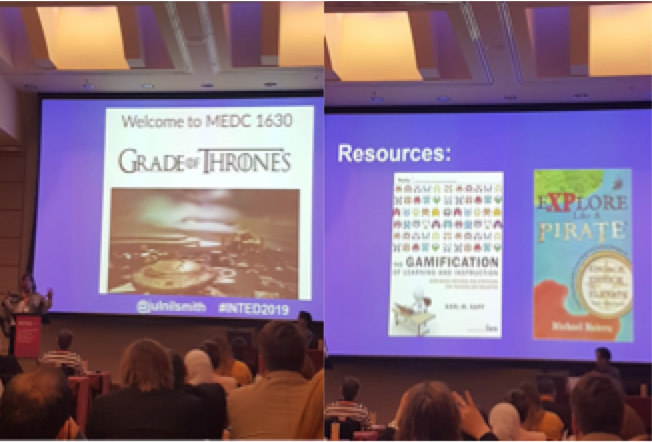
Session: Teacher presence and interaction on an online course in higher education
By S. Sevón1, T. Ylkänen2, M. Åhman-Nylund3
1 Aalto University (FINLAND)
2 JAMK University of Applied Sciences (FINLAND)
3 Centria University of Applied Sciences (FINLAND)
The presenters talked about their pilot project, a higher education online course in Swedish as a second language (Aalto Open Learning), which is a part of the national DIGIJOUJOU project. The course was run in three universities in Fall 2018. They said that despite the benefits of flexible time and the place of online courses, it might be challenging for students to study without getting support from fellow students or teacher as they naturally do in a classroom. The aim of their pilot project was to create a supportive and meaningful online course atmosphere by including teacher presence and collaborative activities. Different forms of teacher presence were created through webinars, weekly information videos and video feedback. Content, instruction and assignments were delivered through multimodal tools. For example, they had webinars at the beginning of the course, weekly videos every Monday,, drop-in sessions, zoom meetings, discussion forums, and e-mails. Both peer and teacher-student feedback were used through versatile feedback methods.For this they used screen-o-matic. They also included consistent small group collaboration as a key element of the course.
The content of the course was based on working life communication, therefore, the assignments required improvement of skills in work life which was shown as one of the motivational aspects of collaboration and interaction among students.
The background information of the course included details like Swedish being the minority language in Finland but the students are expected to learn Swedish. The main focus was on communication, therefore, accuracy or grammar was not considered important. All knowledge is valued as students are experts in their fields and are expected to teach each other.
The challenges of the course were stated as teacher presence and time. Giving feedback took a lot of time, contacting the students was time consuming and struggling with technology was another issue. To save time they suggest incorporating different kinds of feedback and giving the responsibility to students where possible, reusing the videos, prioritizing their tasks and finally, skipping perfection.
Session: Using games in the classroom: Developing customizes lesson plans using the supporting tool game.learn.grow
By E. Vanderhoven, E. De Latter, R. Devis
Arteveldehogeschool (BELGIUM)
The presenters started with some background information about the positive effects of the use of games in the classroom: 1. they can increase pupils’ motivation, 2. they have a positive influence on pupils’ attitudes towards school, and 3. They lead to extracurricular skills such as creativity and complex cognitive skills. They said although primary school teachers in Flanders share a positive attitude towards ICT, they rarely use educational games. Some of the reasons mentioned were that teachers find it hard to select good educational games, and they do not know how to integrate these games in learning activities to optimize learning for all students.
Therefore, they developed ten good-practices using co-design sessions with teachers. These good practices consisted of complete lesson plans based on the curriculum goals of primary education, including all didactical elements of an effective lesson rather than the description of a game. Later, they evaluated all the good practices and revised them. Finally, they formulated four general design guidelines.

The lessons they learnt from this process were:
●The design of learning activities including digital games is a very time consuming process.
●The supply of educational games is also time consuming.
●Teachers need lots of support as it is unrealistic to expect primary school teachers to integrate this process into their daily routine. It is important to involve researchers in the design process during the codesign sessions.
Consequently, they created a support tool “Game.Learn.Grow”. It included a cardbox with a link to a website guiding teachers through the process to develop customized lessons with integrated games by offering good practices as examples. Other supporting materials they provided were game boards, support cards, master cards, cards with good practices, manuals and a website.
The evaluation of the tool revealed promising feedback. They suggest the importance of testing the prototype, usefulness, ease of use and attractiveness.
Session: Flipped learning in German courses
By P. Kudel
Aalto University (FINLAND)
The presenter talked about a strategic development project at the Aalto University, Finland, (A!OLE-Aalto Online Learning) which began in 2016. The aim of the program was to advance the digitalization of learning at Aalto University by developing novel e-learning solutions and pedagogical models for online and blended learning. Also, best practices and models of the program were planned to be used within a wider learning community. You can see some of the programs and workshops provided by the program here. The presentation aimed to demonstrate how flipped learning is transforming German language teaching. Like in their other courses, the main purpose of the program is not to move the teaching to web, but to use opportunities of web to serve students’ needs.
The speaker gave information about the course after giving brief information about what happens in the actual classroom and in the flipped classroom as well as their pros and cons. In complex digitalised teaching and learning processes, there are many changes, such as the role of the teacher and the student, approaches for online learning settings, interaction types and so on. The presenter talked about the pros and cons of the German course they gave. One con is their students currently have only one face-to-face lesson per week. However, flipped learning methods allow students to learn autonomously at their own pace through a large component of the course in an online environment. Their new online module has stated to offer diverse, communicative content which is closer to lively classroom work than traditional web exercises. It has a student-centered approach, more flexible study paths, new online course materials, more effective use of calendar time, more specific feedback (interactive exercises). In the program they do exercises online and discuss issues in mixed groups in class. The philosophy behind language teaching based just on a textbook in a classroom is obsolete.
Their claim is online and blended models enable their students to more flexibly leverage the benefits of a flipped classroom approach. Consequently, there is more classroom time for communicative interaction
which helps maximize the opportunities to improve their oral skills in group work. They believe their pilot course will initiate a long-term model change in the learning culture of German courses.
Session: Pedagogical underpinnings of a multi-disciplinary language learning portal- the connection between theory and practice
T. Votkin1, L. Wallenius2, T. Lehto3, M. Halsas2
1 Aalto University (FINLAND)
2 Haaga-Helia University of Applied Sciences (FINLAND)
3 Laurea University of Applied Sciences (FINLAND)
This paper presentation was about an open-access digital language learning portal called Svenskstudier i buffeformat which is another project developed by one of the teacher teams in the DIGIJOUJOU project, a national development project for digitalizing second language learning in higher education in Finland financed by Ministry of Education. The presentation focused on how pedagogical aspects have affected technical choices in constructing the multi-disciplinary course. The team represented three higher education institutions: Aalto University, Haaga-Helia University of Applied Sciences and Laurea University of Applied Sciences. The portal aims to empower and engage students, within the discipline of their own choice, to study professional Swedish in higher education in the virtual environment.
The portal consists of 45 tasks that students can do within a course or as an extra assignment. Task-based learning, content-based instruction, flipped learning, blended learning, communicative language learning as well as content and language integrated learning (CLIL) have been incorporated as the pedagogical basis. Constructivism and learning in a task-based environment have been integrated as approaches to support the higher education students’ personal curricula and language studies in subject matters of the degree programs in a flexible and motivating way.
For example, as a communicative task, students are expected to deal with a customer complaint. They are provided with background vocabulary and are expected to create an authentic dialogue with a customer in context. They create a video as a final product. Another example is a task that requires finding a job in Sweden. The input involves familiarizing them with different marketing videos. The task is to choose a suitable job and find out more information about it. The skills improved are information seeking, communicating in authentic situations both orally and in writing. As the outcomes of content-based instruction, some tasks require presentations or videos which are all followed up with discussion and reflection. Flipped learning examples can be in pre-activity, activity or post activity formats. For example, if it is an advertisement analysis, the input and task can be given as flipped tasks and simulations, discussions and reflections can be done in the classroom setting. Students are flexible to choose blended learning in online or offline styles. An example of CLIL can be ‘a mystery shopping and customer experience’. The input can be given (study of the concept) in L1 or in the target language, the task can be the application and analysis of the experience (create, test and implement) which is followed by a reflection and a report: the presentation of the experience and discussion.
The process allows interaction with other students and is open to all universities in Finland. It is believed that the study portal motivates students and gives them more responsibility and autonomy in their own learning. One advantage of the portal is students are active content creators, not passive receivers of information. Also, students are encouraged to seek information, to process information in a variety of ways to reach an appropriate output through the guidance of the activities on the portal. During the learning process students are encouraged to choose between a range of digital tools. Some of them are open source tools, web conferencing software, video production and editing tools, games and quizzes and message applications, as well as traditional ways of output. The portal has incorporated and tested various digital tools aimed at improving the command of at least one digital tool that enhances the study process and learning outcome in a natural way.
Session: Student perspectives of online/blended learning as academic continuity solution during #FeesMustFall campus disruptions
D. Scheepers
University of Pretoria (UP) (SOUTH AFRICA)
The presenter introduced student perspectives of a course which had to be created to provide education to South African Higher Education students in 2015 and 2016. Due to student protests, such as #FeesMustFall, #OutsourcingMustFall and #AfrikaansMustFall during this period, there was disruption of classes and assessments because three residential UP campuses were closed for a few days at a time. The protests even resulted in the prohibition of students’ accessibility to campus. Yet, the academic year continued by making alternative materials to on-campus lectures available online. In this way, the students would be able to finish the academic year in December, 2016 as originally scheduled.
They had 6 weeks to closure and everything had to go online on one day. However, it was a reasonable solution because UP had been using blended learning models in support of their courses since 1998. Also, 84% of all undergraduate modules were using the Learning Management System (LMS). Other mediating tools were Blackboard announcements, emails, WhatsApp and Facebook. The content was distributed through narrated PPPs and videos, and assessment was done online, through Blackboard. Some of the challenges they had were, students only focused on blackboard announcements and missed messages going through other systems. They felt overwhelmed and missed messages.Students’ emails to lecturers flooded inboxes and students complained about getting no or limited feedback. The online lectures were given through Blackboard discussion board which was unfamiliar to students. Neither the lecturers not the students were fully prepared to use online tools.
The presentation shared student experiences of the sudden implementation of online learning within UP, and its effect on their learning. Both qualitative and quantitative methodologies were used to collect data. The presenter talked about ‘the activity theory’ by Cole & Engeström to investigate the responses and to understand how they perceived this change, learning and assessment rules as well as the impact it had on their learning.
The results about the preparedness of the participants showed that 53% of students were fully prepared, while 33% were prepared to use most of the technology. The results of the ability for self-directed learning showed a bigger problem. Only 30% of the respondents said they were prepared for self-study. 66% struggled to learn independently which also demonstrated that in certain disciplines it was more difficult to learn independently.40% has connectivity problems, 30% struggled with different assessment strategies. The positive feedback was about the assignments. Most students welcomed assignments instead of tests.
The completion of the course was the same as their normal course 83.18 % in modules and 89.74% in examinations.
